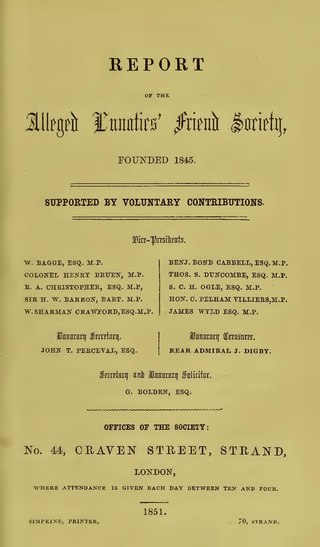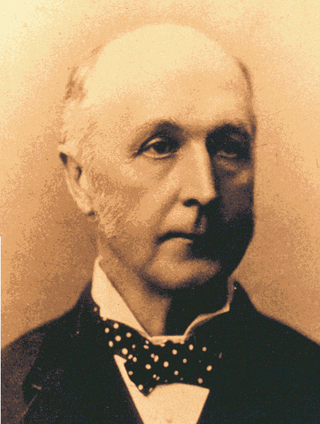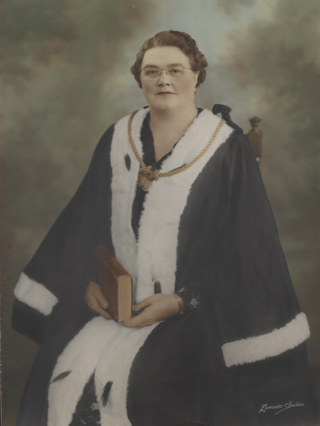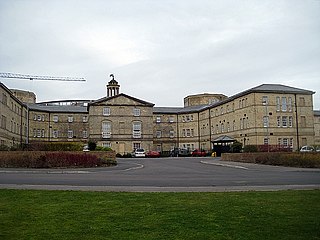
Edward William Davies (1855-1904) was elected mayor of Fremantle, Western Australia, in 1901, but was removed two months later on the grounds of insanity. [1]

Edward William Davies (1855-1904) was elected mayor of Fremantle, Western Australia, in 1901, but was removed two months later on the grounds of insanity. [1]
Davies was the son of Alfred Alexander Davies, who had arrived in Fremantle in 1834 and who had another son, George Alfred Davies, [2] who was born in 1846. Edward Davies was born in Fremantle in 1855. In 1875 his father died, and in December that year Davies married Kate Murray. In July 1876, Davies appeared in court on a charge of seduction brought against him by William Thorpe, a farmer, on behalf of his daughter Rosina.
In the early 1880s Davies became a pawnbroker. At the same time, he was working to improve his social position in Fremantle: he joined local lodges, institutes and societies and was active on their committees, and in 1887 became rate collector to the Fremantle Municipal Council. He eventually resigned as rate collector in August 1888 after protesting that "from the very illiberal manner his demands had received in many quarters since starting in July, in consequence no doubt of the general depression, he felt that his talents were not equal to the occasion." [3] Despite this, Davies took up the position again in early 1890.
With the onset of a gold rush in Western Australia 1893, Davies’ property investments paid dividends and he was elected to Fremantle Municipal Council. In July 1894 he was also elected to the colony's Legislative Council, and in 1897 his profile appeared in W. B. Kimberly's History of West Australia: A narrative of her past, together with biographies of its leading men. The piece noted that ‘there is a happy disposition suggested in his face, which on personal acquaintance is established most emphatically.’ [2]
In April 1900, Davies was also appointed a Justice of the Peace, and on 17 April 1901, he was elected unopposed by the Council as mayor of Fremantle. He was to serve the balance of retiring mayor Edward Solomon's term, and was installed on 26 April 1901.
Davies carried out his initial public duties without attracting comment, but on the night of 17 May 1901, he delivered a furious outburst to a Fremantle Municipal Council meeting. The majority of councillors held a special meeting the following Monday evening to ask for his resignation. Davies attended a football [ clarification needed ] match on 25 May and exhibited ‘erratic behaviour’, and then at a boxing match on 28 May he lavishly distributed money around him. [4]
That evening, Davies was examined by local Fremantle physicians Drs Thomas Davy and William Birmingham and certified as insane. He was removed to the nearby Grosvenor Private Hospital, and Davy told the West Australian newspaper that Davies had ‘been afflicted with a brain disorder for some time past, and the excitement which he had experienced since he became Mayor of the Port, on April 21 [sic] last, had done him so much injury that he had become insane.’ [5] Davies was discharged by court order from the Grosvenor Hospital on around 8 or 9 June 1901. His own doctor, Henry Lotz, later told the Supreme Court that he had treated Davies for gout complicated by heavy drinking in June 1901; that he had recommended the Grosvenor Hospital, and that Davies had gone there and then made ‘a rapid recovery’. [6]
Once released from hospital, Davies refused to resign from the mayorship, forcing the two other candidates for the position to stand down. There were complaints in July 1901 that the ‘three Mayors’ were disrupting the civic management of Fremantle. [7] The situation was eventually resolved and Davies was replaced, but in September 1901 Dr Thomas Davy sued another local newspaper, the Daily News, for publishing a letter which suggested that he had falsely certified Davies. The newspaper admitted the libel, printed a public apology, and paid £50 damages and costs.
Davies was able to travel to England in August 1901 and stayed away for four months. When he returned at the end of 1901, he began spending most of his time indoors in a darkened room, and suffered another attack of gout. Davies’ erratic behaviour also now involved his estate: he ‘purchased a lot of land … [and] raised money by selling the Terminus Hotel, and by mortgaging some other land.’ [8]
In July 1902 Davies told Dr Henry Lotz that he was actually the long-lost son of the Duke of York (who later became King George V), and in August 1902 he complained to Lotz about the influence of X-rays on his mind. Then in May 1903, Davies tried to send a long telegram to Joseph Chamberlain, Secretary of State for the Colonies in London, explaining his Royal origins and claiming the throne of England and a multi-million-pound fortune. He also called the police to investigate his neighbour Mr Allen, who he believed was trying to harm him with an X-ray machine. When the police failed to take him seriously, he accused them of being bribed and eventually ordered them off his premises while ‘shouting out at the top of his voice’. [9] Finally, on 14 June 1903 Davies was taken to Fremantle Lunatic Asylum after threatening to shoot his wife.
Davies’ wife Kate went to the Supreme Court in Lunacy as plaintiff to try to protect the family's estate. The case was heard from 9 to 18 July 1903, and Davies’ defence counsel E A Harney took the line that Davies had been suffering from a temporary aberration caused by alcoholism, that he was not a danger to others, and was capable of managing his affairs. However, J D Moss (representing Kate Davies) was able to show through a string of medical and other witnesses that Davies was not only insane but was unlikely to recover, was dangerous to others, and was legally incapable.
The acting Master in Lunacy (Charles Allen Sherard) cleared the court on 15 July when Davies was placed on the stand for examination. Moss objected, claiming that he had a special direction that the case was to be heard in an open court, but the Master solved this neatly by adjourning the court while he examined Davies privately with the jury. Moss threatened to walk out; the Master remained unmoved, indicating that he would examine Davies and ‘had no objection to counsel being present’. [10]
Sherard then summed up on 18 July 1903 by instructing the jury that Davies’ 1901 certification was not to be considered valid, as he was then suffering from alcoholism and was found later not to be insane. Sherard also told the jury that the case really began with Davies’ behaviour after his return from England in 1901. The jury, however, were unanimous in finding Davies of unsound mind, but in deference to Sherard's instructions they gave the date of his first insanity as 14 June 1903. The foreman explained to the Master after they presented their finding that ‘he and others of the jury were among Mr Davies’ old friends’, and that they were anxious that he be treated in a private hospital, not the lunatic asylum. [11] The court offered to take this into account, and the jury then delivered its verdict of insanity.
Edward Davies returned to Fremantle Lunatic Asylum, and on 15 August was ‘discharged to care of his friends’. [12] Nothing more was heard until his death around six months later, on 24 or 25 January 1904 at the Grosvenor Private Hospital. His obituary mentioned only his business successes, his election to public office, and that he died at his residence in Beaconsfield on 25 January after a long illness. [13] He is buried at Fremantle Cemetery. [14]

Roderick Edward Maclean was a Scotsman who attempted to assassinate Queen Victoria on 2 March 1882, at Windsor, England, with a pistol. This was the last of eight attempts by separate people to kill or assault Victoria over a period of four decades. Maclean's motive was purportedly a curt reply to some poetry that he had mailed to the Queen.
The attempted murder followed the arrival of the Royal train, conveying the Queen, Princess Beatrice and the Court from Windsor. Queen Victoria had just walked across the platform of Windsor station to a carriage in waiting when Maclean, who was standing at the entrance of the station yard among a number of spectators, deliberately fired a revolver at her. The shot missed, and Maclean was seized by Chief Superintendent Hayes, of the Borough Police, and the weapon wrenched from his grasp by someone in the crowd. – Birmingham Daily Gazette, 1921

Barnwood House Hospital was a private mental hospital in Barnwood, Gloucester, England. It was founded by the Gloucester Asylum Trust in 1860 as Barnwood House Institution and later became known as Barnwood House Hospital. The hospital catered for well-to-do patients, with reduced terms for those in financial difficulties. It was popular with the military and clergy, and once counted an archbishop amongst its patients. During the late nineteenth century Barnwood House flourished under superintendent Frederick Needham, making a healthy profit and receiving praise from the Commissioners in Lunacy. Even the sewerage system was held up as a model of good asylum practice. After the First World War service patients, including war poet and composer Ivor Gurney, were treated with a regime of psychotherapy and recreations such as cricket.

The Lunacy Act 1845 or the Lunatics Act 1845 and the County Asylums Act 1845 formed mental health law in England and Wales from 1845 to 1890. The Lunacy Act's most important provision was a change in the status of mentally ill people to patients.

The Fremantle Arts Centre is a historic building complex on Ord Street in Fremantle, Western Australia.

Robert Gardiner Hill MD was a British surgeon specialising in the treatment of lunacy. He is normally credited with being the first superintendent of a small asylum to develop a mode of treatment in which reliance on mechanical medical restraint and coercion could be dropped altogether. In practice he reached this situation in 1838.
The Commissioners in Lunacy or Lunacy Commission were a public body established by the Lunacy Act 1845 to oversee asylums and the welfare of mentally ill people in England and Wales. It succeeded the Metropolitan Commissioners in Lunacy.
Mental health in Singapore has its roots in the West. The first medical personnel in the field were mostly from Britain. Medical education in the early years was almost exclusively for the British, until the establishment of King Edward VII College of Medicine on the island in 1907. Hence, many influential ideas flowed over from the West through the years.

The Alleged Lunatics' Friend Society was an advocacy group started by former asylum patients and their supporters in 19th-century Britain. The Society campaigned for greater protection against wrongful confinement or cruel and improper treatment, and for reform of the lunacy laws. The Society is recognised today as a pioneer of the psychiatric survivors movement.

Kew Lunatic Asylum is a decommissioned psychiatric hospital located between Princess Street and Yarra Boulevard in Kew, a suburb of Melbourne, Australia. Operational from 1871 to 1988, Kew was one of the largest asylums ever built in Australia. Later known as Willsmere, the complex of buildings were constructed between 1864 and 1872 to the design of architects G.W. Vivian and Frederick Kawerau of the Victorian Public Works Office to house the growing number of "lunatics", "inebriates", and "idiots" in the Colony of Victoria.

Yarra Bend Asylum was the first permanent institution established in Victoria that was devoted to the treatment of the mentally ill. It opened in 1848 as a ward of the Asylum at Tarban Creek in New South Wales. It was not officially called Yarra Bend Asylum until July 1851 when the Port Phillip District separated from the Colony of New South Wales. Prior to the establishment of Yarra Bend, lunatic patients had been kept in the District's gaols. Yarra Bend was proclaimed an Asylum under the provisions of the Lunacy Statute 1867 (No.309) in the Government Gazette in October 1867.

Frederick Norton Manning, was a medical practitioner, military surgeon, Inspector General of the Insane for the Colony of New South Wales, and was an Australian Lunatic Asylum Superintendent. He was a leading figure in the establishment of a number of lunatic asylums in the colonies of New South Wales and Victoria, and participated in inquests and reviews of asylums throughout the colonies.

Elizabeth Lilian Maud Fowler MBE, JP was an Australian politician. She was Australia's first female mayor, serving as mayor of Newtown, New South Wales, from 1937 to 1939. She later represented the seat of Newtown in the New South Wales Legislative Assembly from 1944 to 1950. She had a long involvement with the Lang Labor faction of the Australian Labor Party (ALP), which had evolved into a separate party by the time of her election to Parliament.

The Stanley Royd Hospital, earlier named the West Riding Pauper Lunatic Asylum, was a mental health facility in Wakefield, West Yorkshire. It was managed by the Wakefield and Pontefract Community Health NHS Trust.

The lunatic asylum, insane asylum or mental asylum was an early precursor of the modern psychiatric hospital.

Lyttelton Stewart Forbes Winslow MRCP was a British psychiatrist famous for his involvement in the Jack the Ripper and Georgina Weldon cases during the late Victorian era.

Sir Arthur Mitchell MD LLD was a Scottish doctor involved in the study and care of patients with mental illness. He served on several public commissions, and wrote widely on history and anthropology.

Swanbourne Hospital is a heritage listed former mental hospital located in Mount Claremont, Western Australia. Built in 1904, it was the largest stand-alone psychiatric hospital in Western Australia for much of the twentieth century until its closure in September 1972. The hospital was originally known as Claremont Hospital for the Insane, Claremont Mental Hospital and Claremont Hospital. Following the closure of Claremont Hospital in 1972, the original 1904 section of the hospital functioned as the Swanbourne Hospital until 1985. The site was vacant from 1986, until renovated and reopened primarily as an aged care residence in 2018.
Whitby Falls Hospital is a former hospital for the mentally ill located in Mundijong, Western Australia. Until its closure in 2006 it was the longest operating facility in Western Australia for the care and treatment of mental illness.

The Old Manor Hospital was a psychiatric hospital in Salisbury, Wiltshire, England. It was established in the early 19th century as a private licensed house called Fisherton House or Fisherton House Asylum, which became the largest private madhouse in the United Kingdom. In 1924, following a change of proprietors, it was renamed Old Manor Hospital and in 1955 it was amalgamated into the National Health Service. From 1813 to 1955 it was owned and managed by members of the same family. The Old Manor Hospital closed in 2003 and was replaced by Fountain Way, a smaller, modern, psychiatric hospital on part of the same site. In 2014 the site was acquired by Quantum Group for development as a residential estate and the conversion of the main building to a hotel.

Bellsdyke Hospital, also known as Stirling District Lunatic Asylum ('SDLA') or Stirling District Asylum, is a former psychiatric hospital at Larbert, Falkirk that was opened in June 1869 and largely closed in 1997. It was an asylum set up by the Stirling District Lunacy Board.